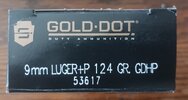peacebutready
Member
There is ballistic gel everyone is familiar with. For this thread, I'd like to keep gel out of the discussion.
What is the street reputation of particular loads using common handgun calibers like 9mm, .40 S&W, .45 ACP, .38 Special, and .357 magnum?
What are loads that did well in which caliber? What loads were disappointing in which caliber?
Let's keep this discussion to what people heard/read from good sources, and perhaps experienced themselves. Also, lets keep this to what people have heard, read, or experienced in the past few or several years.
An example of an answer may be: The 115gr XYZ 9mm hollow point bullet has been shown to penetrate insufficiently. Or, the 165gr ABC .40 S&W hollow point has acquired an excellent reputation for the use of defense.
What is the street reputation of particular loads using common handgun calibers like 9mm, .40 S&W, .45 ACP, .38 Special, and .357 magnum?
What are loads that did well in which caliber? What loads were disappointing in which caliber?
Let's keep this discussion to what people heard/read from good sources, and perhaps experienced themselves. Also, lets keep this to what people have heard, read, or experienced in the past few or several years.
An example of an answer may be: The 115gr XYZ 9mm hollow point bullet has been shown to penetrate insufficiently. Or, the 165gr ABC .40 S&W hollow point has acquired an excellent reputation for the use of defense.


